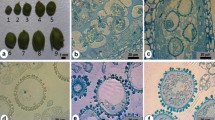Summary
Donor plants of Hordeum vulgare L. cv. Igri were grown in a conditioned environment to minimise fluctuations in the composition of the microspore population. After isolation different types of microspores were identified within each population, amongst others an embryogenic subpopulation. It was shown that the optimum plating density is achieved by adjusting the density to 2×104 embryogenic microspores per ml, with a lower threshold at 5×103 per ml. By increasing the osmolality of the pretreatment solution to 440 mOs.kg−1 and that of the culture medium to 350 mOs.kg−1, up to 15% of the population developed into embryo-like structures. When microspores of cv. Igri were cultured under the optimized conditions, the ratio of green/albino plants increased from 1∶1 to 34∶1, and 50 green plants per anther were formed.
Similar content being viewed by others
References
Bolik M, Koop HU (1991) Identification of embryogenic microspores of barley (Hordeum vulgare L.) by individual selection and culture and their potential for transformation by microinjection. Protoplasma 162:61–68
Cho MS, Zapata FJ (1990) Plant regeneration from isolated microspores of Indica rice. Plant Cell Physiol 31(6):881–885
Chu CC, Hill RD, Brule-Babel AL (1990) High frequency of pollen embryoid formation and plant regeneration in Triticum aestivum L. on monosaccharide containing media. Plant Science 66:255–262
Coumans MP, Sohota S, Swanson EB (1989) Plant development from isolated microspores of Zea mays L. Plant Cell Reports 7:618–621
Datta SK, Wenzel G (1987) Isolated microspore derived plant formation via embryogenesis in Triticum aestivum L. Plant Science 48:49–54
Deslauriers C, Powell AD, Fuchs K, Pauls KP (1991) Flow cytometric characterization and sorting of cultured Brassica napus microspores. Biochemica et Biophysica Acta 1091:165–172
Gaillard A, Mattys-Rochon E, Dumas C (1992) Selection of microspore derived embryogenic structures in maize related to transformation potential by microinjection. Bot Acta 105:313–318
Gaillard A, Vergne P, Beckert M (1991) Optimization of maize micropsore isolation and culture conditions for reliable plant regeneration. Plant Cell Reports 10:55–58
Heberle-Bors E (1989) Isolated pollen culture in tobacco: plant reproductive development in a nutshell. Sex Plant Reprod 2:1–10
Hoekstra S, van Zijderveld MH, Louwerse JD, Heidekamp F, van der Mark F (1992) Anther and microspore culture of Hordeum vulgare L. cv. Igri. Plant Science 86:89–96
Huang B, Bird S, Kemble R, Simmonds D, Keller W, Miki B (1990) Effects of culture density conditioned medium and feeder cultures on microspore embryogenesis in Brassica napus L. cv. Topas. Plant Cell Reports 8:594–597
Huang B, Sunderland N (1982) Temperature-stress in barley anther culture. Ann Bot 49:77–88
Kao KN (1981) Plant formation from barley anther cultures with Ficoll media. Z. Pflanzenphysiol 103:437–443
Kuhlmann U, Foroughi-Wehr B, Graner A, Wenzel G (1991) Improved culture system for microspores of barley to become a target for DNA uptake. Plant Breeding 107:165–168
Kyo M, Harada H (1985) Studies on conditions for cell division and embryogenesis in isolated pollen culture of Nicotiana rustica. Plant Physiol 79:90–94
Olsen FL (1991) Isolation and cultivation of embryogenic microspores from barley (Hordeum vulgare L.). Hereditas 115:255–266
Pescitelli SM, Johnson CD, Petolino JF (1990) Isolated microspore culture of maize: effects of isolation technique reduced temperature and sucrose level. Plant Cell Reports 8:628–631
Zhou H, Zheng Y, Konzak CF (1991) Osmotic potential of media affecting green plant percentage in wheat anther culture. Plant Cell Reports 10:63–66
Author information
Authors and Affiliations
Additional information
Communicated by H. Lörz
Rights and permissions
About this article
Cite this article
Hoekstra, S., van Zijderveld, M.H., Heidekamp, F. et al. Microspore culture of Hordeum vulgare L.: the influence of density and osmolality. Plant Cell Reports 12, 661–665 (1993). https://doi.org/10.1007/BF00233415
Received:
Revised:
Issue Date:
DOI: https://doi.org/10.1007/BF00233415




